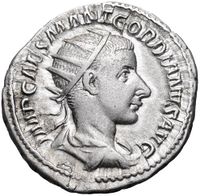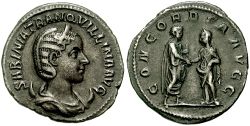گورديان الثالث
| گورديان الثالث | |||||
|---|---|---|---|---|---|
| الإمبراطور رقم 32 للإمبراطورية الرومانية | |||||
 تمثال رأسي لگورديان الثالث ما بين 242 و244 | |||||
| العهد | 22 أبريل – 29 يوليو 238 (as Caesar to Pupienus and Balbinus); 29 يوليو 238 – 11 فبراير 244 (sole, nominally, though government done by senate) | ||||
| سبقه | Pupienus and Balbinus | ||||
| تبعه | Philip the Arab | ||||
| وُلِد | 20 يناير 225 | ||||
| توفي | 11 فبراير 244 Zaitha | ||||
| الزوجة |
| ||||
| |||||
| الأسرة المالكة | Gordiani | ||||
| الأب | Unnamed Roman Senator | ||||
| الأم | Antonia Gordiana | ||||
گورديان الثالث (لاتينية: Marcus Antonius Gordianus Pius Augustus;[1] 20 يناير 225 – 11 فبراير 244)، إمبراطور روماني 238-244. في سن ال 13، كان أصغر إمبراطور روماني خلال الامبراطورية الرومانية. وهو ابن أنطونيا گورديان وعضو المجلس الروماني الذي توفي قبل 238. أنطونيا گورديان كانت ابنة الامبراطور گورديان الأول ، والشقيقة الصغرى للإمبراطور گورديان الثالث. وسمي بهذا الأسم نسبة لجده لأمه في 238.
. . . . . . . . . . . . . . . . . . . . . . . . . . . . . . . . . . . . . . . . . . . . . . . . . . . . . . . . . . . . . . . . . . . . . . . . . . . . . . . . . . . . . . . . . . . . . . . . . . . . . . . . . . . . . . . . . . . . . . . . . . . . . . . . . . . . . . . . . . . . . . . . . . . . . . . . . . . . . . . . . . . . . . . .
صعود الى السلطة
 Aureus of Gordian III. Inscription: IMP. CAES. M. ANT. GORDIANVS AVG. |
In 235, following the murder of Emperor Alexander Severus in Moguntiacum (modern Mainz),[2] the capital of the Roman province Germania Superior, Maximinus Thrax was acclaimed emperor.[3] In the following years, there was a growing opposition against Maximinus in the Roman Senate and amongst the majority of the population of Rome. In 238, a rebellion broke out in the Africa Province, where Gordian's grandfather and uncle, Gordian I and II, were proclaimed joint emperors.[4] This revolt was suppressed within a month by Cappellianus, governor of Numidia and a loyal supporter of Maximinus Thrax.[4]
The Senate, showing its hostility towards Maximinus by supporting the Gordiani, elected Pupienus and Balbinus as joint emperors.[5] These senators were not popular men, so the Senate decided to raise Marcus Antonius Gordianus to the rank of Caesar.[6] Maximinus, moving quickly to attack the Senate's newly elected emperors, encountered difficulties marching his army through an Alpine winter.[6] Arriving at Aquileia and short on supplies, Maximinus besieged the city.[6] After four weeks, Maximinus' demoralized army mutinied and the Legio II Parthica murdered him.[7]
The situation for Pupienus and Balbinus, despite Maximinus' death, was doomed from the start with popular riots, military discontent and an enormous fire that consumed Rome in June 238. The next month, Pupienus and Balbinus were killed by the Praetorian Guard and Gordian proclaimed sole emperor.[8]
الحكم


Due to Gordian's age, the imperial government was surrendered to the aristocratic families, who controlled the affairs of Rome through the Senate.[9] In 240, Sabinianus revolted in the African province, but he was quickly defeated.[10] In 241, Gordian was married to Furia Sabinia Tranquillina,[11] daughter of the newly appointed praetorian prefect, Timesitheus. As chief of the Praetorian Guard and father in law of the Emperor, Timesitheus quickly became the de facto ruler of the Roman Empire.[12]
During Gordian's reign there were severe earthquakes, so severe that cities fell into the ground along with their inhabitants.[13] In response to these earthquakes Gordian consulted the Sibylline books.[13]
By the 3rd century, the Roman frontiers weakened against the Germanic tribes across the Rhine and Danube, and the Sassanid Empire across the Euphrates increased its own attacks. When the Sasanians under Shapur I invaded Mesopotamia, the young emperor opened the doors of the Temple of Janus for the last time in Roman history, and sent a large army to the East. The Sassanids were driven back over the Euphrates and defeated in the Battle of Resaena (243).[14] The campaign was a success and Gordian, who had joined the army, was planning an invasion of the enemy's territory, when his father-in-law died in unclear circumstances.[15] Without Timesitheus, the campaign, and the Emperor's security, were at risk. Due to the campaign's success, Gordian celebrated with a triumph and boasted about his achievements to the Senate.[13]
| |||||
Gaius Julius Priscus and, later on, his own brother Marcus Julius Philippus, also known as Philip the Arab, stepped in at this moment as the new Praetorian Prefects.[16] Gordian would then start a second campaign. Around February 244, the Sasanians fought back fiercely to halt the Roman advance to Ctesiphon.
The eventual fate of Gordian after the battle is unclear. Roman sources claim that the soldiers proclaimed Philip the Arab emperor, that he made peace with Shapur on "shameful" terms, and that Gordian died as the Roman forces departed for the west.[17] Zonaras says that Gordian died after falling from his horse during a battle.[17] An inscription erected by Shapur claims that a battle occurred (Battle of Misiche) near modern Fallujah (Iraq), which resulted in a major Roman defeat and the death of Gordian III,[18] after which Philip bought peace for 500,000 dinars.[17] One view holds that Gordian died at Zaitha, murdered by his frustrated army, while the role of Philip is unknown.[19] Scholarly analyses suggest the Sasanian version, "while defective[,] is superior" to the Roman one, which provides no explanation for why the victorious Roman army had to make peace on disadvantageous terms.[17]
The deposition of Gordian's body is also a matter of controversy. According to David S. Potter, Philip transferred the body of the deceased emperor to Rome and arranged for his deification.[20] Edwell, Dodgeon, and Lieu state that Philip had Gordian buried at Zaitha after the campaign against the Sasanians had ended in failure.[21][22]
شجرة العائلة
قالب:Gordian dynasty family tree
المصادر
- ^ في اللاتينية الكلاسيكية، Gordian's name would be inscribed as MARCVS ANTONIVS GORDIANVS PIVS AVGVSTVS.
- ^ Drinkwater 2007, p. 28.
- ^ Drinkwater 2007, p. 29.
- ^ أ ب Raven 1993, p. 142.
- ^ Drinkwater 2007, pp. 31-32.
- ^ أ ب ت Drinkwater 2007, p. 32.
- ^ Varner 2004, p. 200.
- ^ Drinkwater 2007, p. 33.
- ^ Potter 2004, p. 171.
- ^ Wilhite 2007, p. 31.
- ^ Townsend 1934, p. 84.
- ^ Mennen 2011, p. 34.
- ^ أ ب ت Boin 2018, p. 61.
- ^ Tucker 2010, p. 147.
- ^ Chisholm 1911.
- ^ Potter 2004, p. 236.
- ^ أ ب ت ث Shahbazi 2017.
- ^ Brosius 2006, p. 144.
- ^ Potter 2004, pp. 234,236.
- ^ Potter 2004, p. 238.
- ^ Edwell 2020.
- ^ Dodgeon & Lieu 1991, p. 41.
- تحوي هذه المقالة معلومات مترجمة من الطبعة الحادية عشرة لدائرة المعارف البريطانية لسنة 1911 وهي الآن من ضمن الملكية العامة.
- Meckler, Michael, "Gordian III (238–244 A.D.)", De Imperatoribus Romanis
- Ammianus Marcellinus, The Later Roman Empire (AD354-378), 23.5.3
وصلات خارجية
| ألقاب ملكية | ||
|---|---|---|
| سبقه Pupienus and Balbinus |
إمبراطور روماني 238–244 |
تبعه فيليپ العربي |
| مناصب سياسية | ||
| سبقه Fulvius Pius, Pontius Proculus Pontianus |
قنصل الامبراطورية الرومانية 239 مع Manius Acilius Aviola |
تبعه Gaius Octavius Appius Suetrius Sabinus , Ragonius Venustus |
| سبقه Gaius Octavius Appius Suetrius Sabinus , Ragonius Venustus |
قنصل الامبراطورية الرومانية 241 مع Clodius Pompeianus |
تبعه Gaius Vettius Gratus Atticus Sabinianus , Gaius Asinius Lepidus Praetextatus |
- Articles containing لاتينية-language text
- Pages using Lang-xx templates
- مقالات مأخوذة من الطبعة الحادية عشرة لدائرة المعارف البريطانية
- مواليد 225
- وفيات 244
- جرائم 244
- أباطرة رومان من القرن 3
- قناصل الإمبراطورية الرومانية
- أزمة القرن الثالث
- أباطرة رومان قتلوا على يد الحرس الإمبراطوري
- أباطرة رومان مؤلهون
- حكام أطفال قدماء